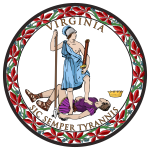
The 17th United States Congress was a meeting of the legislative branch of the United States federal government, consisting of the United States Senate and the United States House of Representatives. While its term was officially March 4, 1821, to March 4, 1823, during the fifth and sixth years of James Monroe's presidency, its first session began on December 3, 1821, ending on May 8, 1822, and its second session began on December 2, 1822, to March 3, 1823. The apportionment of seats in the House of Representatives was based on the 1810 United States census. Both chambers had a Democratic-Republican majority.

The 1822–23 United States House of Representatives elections were held on various dates in various states between July 1, 1822, and August 14, 1823. Each state set its own date for its elections to the House of Representatives before the first session of the 18th United States Congress convened on December 1, 1823. They occurred during President James Monroe's second term.
The 1820–21 United States House of Representatives elections were held on various dates in various states between July 3, 1820, and August 10, 1821. Each state set its own date for its elections to the House of Representatives before the first session of the 17th United States Congress convened on December 3, 1821. They coincided with President James Monroe winning reelection unopposed.
The 1818–19 United States House of Representatives elections were held on various dates in various states between April 26, 1818 and August 12, 1819. Each state set its own date for its elections to the House of Representatives before the first session of the 16th United States Congress convened on December 6, 1819. They occurred during President James Monroe's first term. Also, newly admitted Alabama elected its first representatives in September 1819, increasing the size of the House to 186 seats.

The 1821 United States House of Representatives elections in New York were held from April 24 to 26, 1821, to elect 27 U.S. Representatives to represent the State of New York in the United States House of Representatives of the 17th United States Congress.

The 1822 United States House of Representatives elections in New York were held from November 4 to 6, 1822, to elect 34 U.S. Representatives to represent the State of New York in the United States House of Representatives of the 18th United States Congress.

Pennsylvania elected its members October 10, 1820.

Kentucky elected its members August 7, 1820.
This was the first election in Massachusetts after the separation of the former District of Maine as the new State of Maine, taking the old 14th – 20th districts with it.

New Jersey elected its members November 7, 1820. There were an unusually large number of candidates, 119 candidates according to one contemporary newspaper. Some candidates ran under an "Anti-Caucus" ticket. Only 1 of the 6 six incumbents would serve in the next term, as 4 retired and 1 died after re-election.

Ohio elected its members October 10, 1820.

South Carolina elected its members October 9–10, 1820.

On December 20, 1820, Jesse Slocumb (DR) of North Carolina's 4th district died. A special election was held to fill the resulting vacancy.

On May 15, 1820, David Fullerton (DR) of Pennsylvania's 5th district resigned from his seat in the House of Representatives. A special election was held on October 10, 1820, to fill the resulting vacancy. This election was held on the same day as the election for the 17th Congress.
A special election was held in Maine's at-large congressional district on November 7, 1820, to fill a vacancy left by the resignation of John Holmes. Holmes had been elected under the authority of the State of Massachusetts to that state's former 14th district, part of the District of Maine. When, on March 15, 1820, the former District was granted statehood as the State of Maine, Holmes was elected one of its first two Senators. Under the act admitting Maine as a state, seven seats were moved from Massachusetts to Maine for the 17th Congress, and any vacancies in the 16th Congress that arose in seats held by residents of Maine were to be filled by residents of the new state.

Virginia lost one seat in reapportionment following the 1820 United States census. Nineteen incumbents ran for re-election, leaving three open seats. Virginia elected its members in April 1823 after the term began, but before the new Congress convened.

This was the first election in Maine since its separation from Massachusetts. In the previous election, Massachusetts had had 20 representatives. Seven seats were reassigned from Massachusetts to Maine. In addition, under the terms of the law which admitted Maine to the union, any vacancies in the 16th Congress by Representatives elected to represent Massachusetts but residing in the new states of Maine would be filled by a resident of Maine. John Holmes, who had been elected to the House for the former 14th district of Massachusetts was elected as one of the first two senators for Maine. The vacancy was filled in a special election by Joseph Dane (Federalist). Dane was the only Representative officially considered as representing Maine in the 16th Congress. The Representatives from the 15th-20th districts were still classified as being from Massachusetts for the remainder of the 16th Congress.

North Carolina elected its members August 9, 1821, after the term began but before the new Congress convened.











